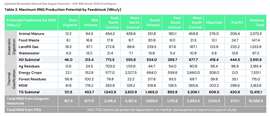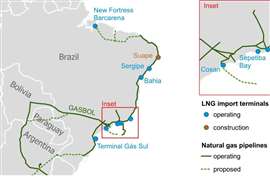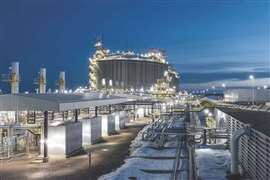U.S. renewable gas production potential grows amid decarbonization push
July 10, 2025
AGF study finds RNG could supply more than half of residential gas demand by 2050 under net-zero scenario
The American Gas Foundation (AGF) has released its updated assessment of renewable natural gas (RNG) supply potential, showing that U.S. production capacity could more than quadruple by 2050 under an ambitious decarbonization scenario.
The study, conducted by global consultancy ICF and published in July 2025, finds that RNG could play a major role in reducing greenhouse gas (GHG) emissions across hard-to-decarbonize sectors, particularly in residential, commercial, and industrial heating as well as transportation.
The report outlines three production scenarios—Low, High, and Ambitious Emissions Reduction—based on varying levels of feedstock utilization, market deployment, and technology maturity. In the Low Scenario, RNG production could reach 1,628 trillion Btu (tBtu) annually by 2050, equal to about one-third of current residential gas use. In the High Scenario, output increases to 3,728 tBtu/year. But under the most aggressive net-zero-oriented pathway, the Ambitious scenario, RNG supply could hit 7,061 tBtu/year—enough to meet roughly 146% of current residential gas demand.

These gains are driven by an expanded range of feedstocks and improved estimates of technical resource availability. The study incorporates updated data from the U.S. Department of Energy’s 2023 Billion-Ton Report, as well as recent updates from the USDA and EPA. Compared to AGF’s 2019 study, total RNG potential has risen by 17%, even as stricter sustainability filters were applied to feedstock use.
Feedstock diversity and technology development widen RNG pathway
RNG can be produced from several types of organic waste, including landfill gas, food waste, animal manure, wastewater sludge, municipal solid waste (MSW), and crop and forestry residues. AGF’s report examines production via two major pathways—anaerobic digestion (AD) and thermal gasification (TG)—as well as a third, emerging route: power-to-gas (P2G) using methanated hydrogen.
Energy crops and agricultural residues represent the largest sources of technical potential, accounting for over 9,500 tBtu/year. Animal manure and MSW add nearly another 4,600 tBtu/year, though practical and economic constraints reduce achievable supply in the nearer term. Landfill gas and wastewater-derived RNG offer some of the most cost-effective sources and are expected to populate the lower end of the RNG supply curve.
In addition to biomass-based sources, the study considers synthetic RNG created by combining renewable hydrogen with captured carbon dioxide in a methanation process. Based on assumptions of using 10–40% of U.S. wind, solar, and nuclear power for electrolysis, ICF estimates up to 472 tBtu/year of P2G-derived RNG could be produced by 2050.
The report also models the emissions reduction potential of RNG under each scenario. By displacing geologic natural gas, RNG could reduce annual U.S. GHG emissions by between 82 and 328 million metric tons (MMT) by midcentury. An additional 6 to 32 MMT could be cut using power-to-gas hydrogen, depending on the deployment level.
ICF calculates that most RNG production will fall in the cost range of $15–$40 per MMBtu by 2050, with landfill and wastewater projects at the lower end and manure, food waste, and thermal gasification at the higher end. While still costlier than fossil gas, the report argues that RNG’s lifecycle emissions benefits translate to abatement costs in the competitive $70–$400/ton CO2e range—on par with or better than other decarbonization strategies.
Policy, innovation key to market expansion
The report underscores the importance of ongoing technological innovation and supportive policies to unlock RNG’s full potential. Advancements in gasification, feedstock collection, and carbon capture technologies could bring down costs and widen the feasibility of more challenging feedstocks. Moreover, clearer frameworks for evaluating RNG’s carbon intensity and its role in clean fuel standards will be critical.
In summary, the AGF study positions RNG as a pivotal part of the clean energy transition. With broad feedstock availability, a growing project base, and increasing policy alignment, renewable gas has the potential to serve as a scalable, low-carbon alternative that leverages existing pipeline infrastructure while supporting climate goals across multiple sectors.
MAGAZINE
NEWSLETTER

CONNECT WITH THE TEAM









